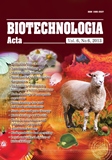ISSN 2410-776X (Online),
ISSN 2410-7751 (Print)

"Biotechnologia Acta" v. 6, no 6, 2013
https://doi.org/10.15407/biotech6.06.071
Р. 71-76, Bibliography 21, Russian.
Universal Decimal classification: 546.26.043
THE AGGREGATE STATE OF C60-FULLERENE IN VARIOUS MEDIA
І. І. Grynyuk1, S. V. Prylutska1, N. S. Slobodyanik1, О. Yu. Chunikhin2, О. P. Matyshevska1
1Taras Shevchenko National University of Kyiv, Ukraine
2Palladin Institute of Biochemistry of National Academy Sciences of Ukraine, Kyiv
The distribution of pristine C60-fullerene nanoparticles by volume and number in water solution without chemical dispersants with different salt and protein composition was evaluated using the correlation spectroscopy analysis. It was shown, that water colloid solution contains C60-fullerene particles with hydrodynamic diameter from 38 to 600 nm, and the main peak position is at 43 nm. In saline solution (0,9% NaCl) the particle size distribution range enlarges that may result from the C60 aggregation. Albumin introducing into the medium promotes dispersed state of C60 nanoparticles and prevents their spontaneous as well as NaCl-dependent agglomeration. No obvious aggregation was detected when C60-fullerene in concentration 10–5 М was added to RPMI medium containing 5% fetal bovine serum. The data show that stable homogenous water colloid solution of pristine C60 fullerene could be used for studding cell respon ses in cultural medium.
Key words: C60-fullerene, photon correlation spectroscopy, albumin, agglomeration.
© Palladin Institute of Biochemistry of National Academy of Sciences of Ukraine, 2013
References
1. Jensen A. W., Wilson S. R., Schuster D. I. Biological applications of fullerenes. Bioorg. Med. Chem. 1996, V. 4, P. 767–779.
2. Bakry R., Vallant R. M., Najamul-Haq M. Medicinal applications of fullerenes. Intern. J. Nanomed. 2007, 2 (4), Р. 639–649.
3. Piotrovskii L. B., Eropkin M. Yu., Eropkina M. A. The mechanisms of the biological action of fullerenes - dependence on the state of aggregation. Psikhofarm. biol. narkol. 2007, 7 (2), 1548–1554. (In Russian).
4. Horie M., Nishio K., Kato H. In vitro evaluation of cellular responses induced by stable fullerene C60 medium dispersion. J. Biochem. 2010, V. 148, P. 289–298.
http://dx.doi.org/10.1093/jb/mvq068
5. Levi N., Hantgan R. R., Lively M. O. C60-Fullerenes: detection of intracellular photoluminescence and lack of cytotoxic effects. J. Nanobiotechnol. 2006, V. 4, P. 14–25.
http://dx.doi.org/10.1186/1477-3155-4-14
6. Moussa F., Trivin F., Ceolin R. Early effects of C60 administration in Swiss mice: a premilionary account for in vivo C60 toxicity. Full. Sci. Technol. 1996, V. 4, P. 21–29.
http://dx.doi.org/10.1080/10641229608001534
7. Andrievsky G. V., Klochkov V., Derevyanchenko L. Is C60 fullerene molecule toxic. Fuller. Nanotub. Carbon Nanostruct. 2005, V. 13, P. 363–376.
http://dx.doi.org/10.1080/15363830500237267
8. Prilutska S. V., Griniuk І. І., Golub O. A. Assessment of cytotoxicity parameters C60 and C60 fullerene-containing composites in vitro. Dop. NAN Ukrainy. 2006, N 1, P. 163–167. (In Ukrainian).
9. Buford M. C., Hamilton Jr. R. F., Holian A. A comparison of dispersing media for various engineered carbon nanoparticles. Part. Fibre Toxicol. 2007, 4 (6).
https://doi.org/10.1186/1743-8977-4-6
10. Deguchi S., Yamazaki T., Mukai S. A. Stabilization of C60 nanoparticles by protein adsorption and its implications for toxicity studies. Chem. Res. Toxicol. 2007, V. 20, P. 854–858.
https://doi.org/10.1021/tx6003198
11. Scharff P., Risch K., Carta-Abelmann L. Structure of C60 fullerene in water: spectroscopic data. Carbon. 2004, V. 42, Р. 1203–1206.
12. Scott E. McNeil. Characterization of nanoparticles intended for drug delivery. Нumana press. 2011, P. 283.
13. Sayes C. M., Fortner I. D., Guo W. The differential cytotoxicity of water-soluble fullerenes. Nano Lett. 2004, V. 4, P. 1881–1887.
https://doi.org/10.1021/nl0489586
14. Labille J., Brant J., Villieras F. Affinity of C60 fullerene with water. Fuller. Nanotub. Carbon Nanostruct. 2006, V. 14, P. 307–314.
https://doi.org/10.1080/15363830600665250
15. Chen K. L., Elimelech M. Aggregation and Deposition Kinetics of Fullerene (C60)?Nanoparticles. Langmuir. 2006, V. 22, Р. 10994–11001.
16. Grynyuk I., Grebinyk S., Prylutska S. Photoexcited fullerene C60 disturbs prooxidant-antioxidant balance in leukemic L1210 cells. Mat.-wiss. u. Werkstofftech. 2013, 44 (2–3), 139–143.
https://doi.org/10.1002/mawe.201300105
17. Deguchi S., Alargova R. G., Tsujii K. Stable dispersions of fullerenes, C60 and C70, in water. Preparation and Characterization. Langmuir. 2001, 17 (19), 6013–6017.
https://doi.org/10.1021/la010651o
18. Mchedlov-Petrossyan N. O., Klochkov V. K., Andrievsky G. V. Colloidal dispersions of fullerene C60 in water: some properties and regularities of coagulation by electrolytes. J. Chem. Soc. Faraday Trans. 1997, 93 (24), 4343–4346.
https://doi.org/10.1039/a705494g
19. Brant J. A., Labille J., Bottero J.-Y. Characterizing the impact of preparation method on fullerene cluster structure and chemistry. Langmuir. 2006, 22 (8), 3878–3885.
https://doi.org/0.1021/la053293o
20. Elimelech M., Gregory J., Jiа X., Williams R. A. Particle deposition and aggregation: measurement, modelling and simulation. Butterworth-Heinemann: Oxford, U.K. 1995.
21. Neumeyer A., Bukowski M., Veith M. Propidium iodide labeling of nanoparticles as a novel tool for the quantification of cellular binding and uptake. Nanomedicine. 2011, 7 (4), 410–419.
http://dx.doi.org/10.1016/j.nano.2010.12.007

